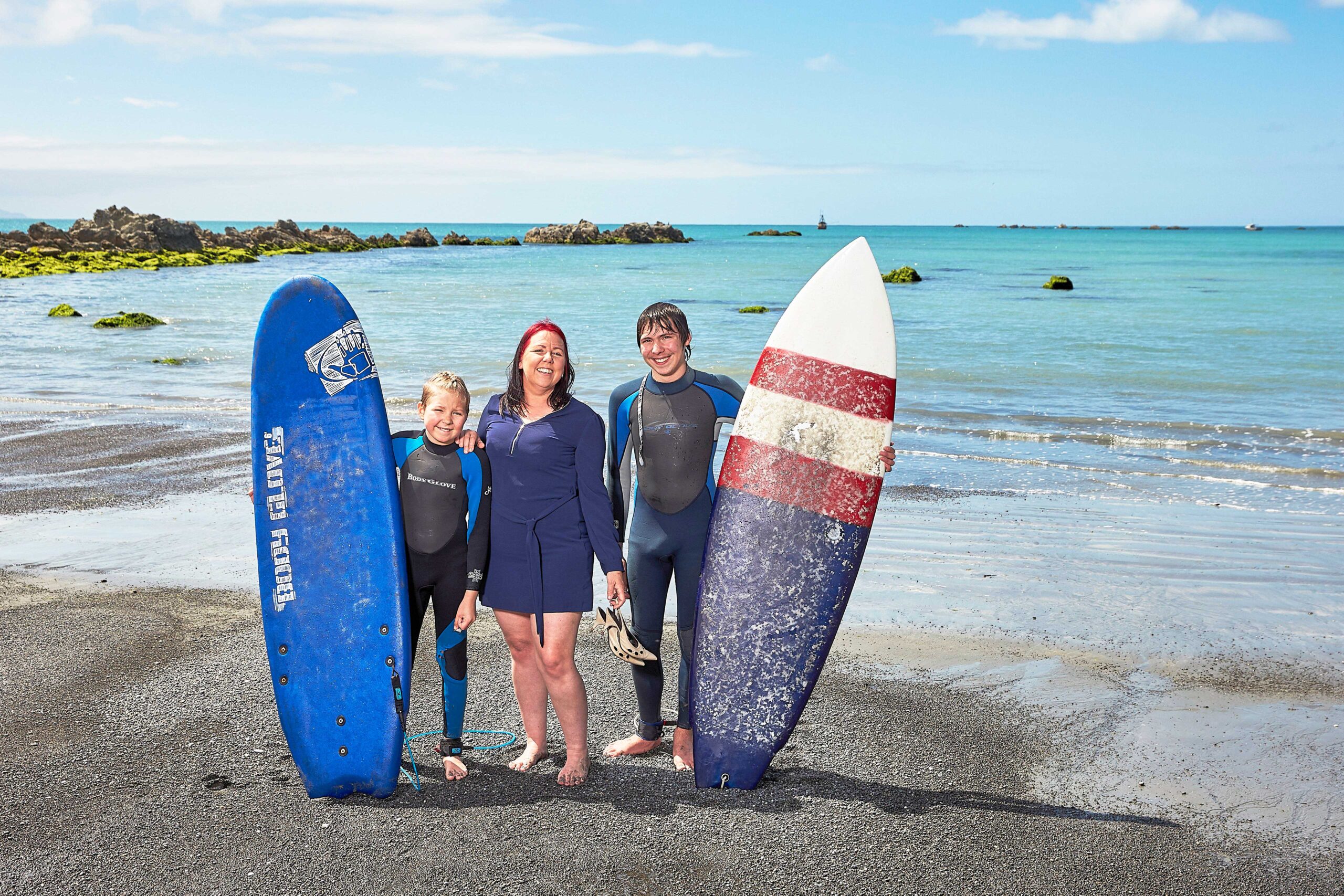Destruction, rubble, mess and waste – the tangible and painful reminders of the terror an earthquake brings in the communities it strikes.
But out of the rubble can come joy and hope, two things a mother-of-two from North Canterbury is determined to spark in others.
Natalie Absalom (41) knows all too well how every aspect of life can change after a natural disaster – she was unlucky enough to experience both the Christchurch and Kaikoura earthquakes first hand.
“It was just like September 2010 all over again,” Natalie says, describing the 7.8- magnitude quake in Kaikoura on November 14 last year.
“I think I was a little bit braver the second time – I knew what was going to happen. I heard things smashing and I knew we were going to lose power. I had a good idea of what the next few days were going to be like.”

Natalie and her surfer sons Neith (left, 10) and Nissa (15).
In the light of day, Natalie – who hails from Greta Valley – assessed the damage in her house and on her land. She explains that one year on, progress is happening, albeit very slowly. “Things are a long way from okay. Until we get roads that are trustworthy, we’re a long way from being recovered.
“We have an army of men and women working so hard to provide Kaikoura stable access to and from the region. But there are times where we are completely isolated. As soon as there is a weather event or an accident, then you have a period of time where no-one can get in and out.”
But it’s the psychological toll an event such as this has on the lives of residents that is felt most, tells Natalie. “It’s that loss of control. You lose autonomy over all parts of your life that you wouldn’t even consider. I knew that was coming because I’d lived it before.”
It was taking on a new role at Kaikoura District Council as a case manager for waste minimisation that gave Natalie a lightbulb moment about how to turn the waste from damaged houses into something positive – and the inspiration came from none other than her two sons Nissa (15) and Neith (10).

“My role focuses on helping people identify asbestos in their earthquake-damaged properties and help people to remove hazardous materials from their properties,” she explains. “So we are all learning about what you can do with broken houses.
“My boys are surfers. All they want to do is be out in the ocean. We have many young people like them here who were caught by this quake. They can’t leave and because there’s been a lot of economic disruption, those extracurricular things go first. So I thought, how hard can it be to turn a house into a surfboard – or even a skateboard?”
Teenagers will be able to make their own specially-branded Kaikoura skateboards thanks to the support of New Zealand company Goose Boards, as well as alaia surfboards, traditional boards made from solid wood that original Hawaiian surfers used.
“At this stage, we can tell the kids where the wood has come from too, and that’s something I’d love to keep going,” Natalie adds. For the ingenious mum, turning tragedy into artwork may only be a small action,
but it’s a positive step towards healing her community as it struggles after the earthquake.
“If you think of a tragedy as a bit of a rip, these are just a couple of weaves fixing that rip. You’ll never take the rip away – there’s always going to be a weave through it – but you want to honour it too,” she says.

“This earthquake changed us. We’re not ever going to be the same people we were before. Instead, we should take these tragedies and let them add to the fabric of our souls, and grow to become more robust and colourful people. And I hope this is as healing for someone else as it is for me. To actually physically change a tragedy into something that’s really cool… It really benefits my soul.”
One more question remains – will this foray into the skating world be enough to get Natalie on a skateboard?
She laughs, “There is a woman here from Christchurch who teaches girls how to skate, so I’m going to get her to teach me. Why not?”
.jpg)
